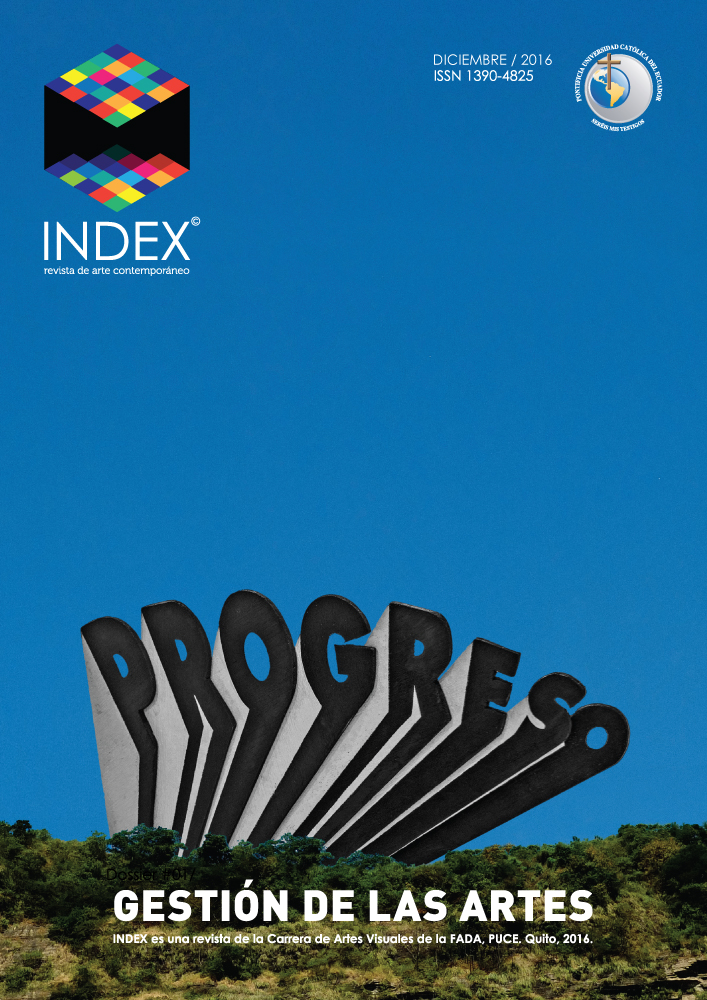ART AS THEOLOGY. INTRODUCTION TO BYZANTINE ICONOLOGICAL PERSPECTIVE AND AESTHETICS
Main Article Content
Abstract
Byzantine aesthetic discourse is firmly related to the theological dogma, specifically the Christological one. This study highlights the meaning of this debate, based on the fact that it relates to a still existing artistic experience. This essay tries to connect the elements of theology on Byzantine icons, with eastern tradition and meanings of art in contemporary eastern and western thinkers. These definitions favor the work of art, rather than a form of cultural objectification, as a way of realizing the “truth”. It is assumed that respect to Christian art as well as the “truth” rather than a philosophical concept or intellectual operation, establishes a specific person: the person of Christ, the “Theanthropos”.
Key words: icon, byzantine, art, aesthetic, Christianism.
Downloads
Article Details
Index, revista de arte contemporáneo maneja sus derechos bajo licencia Creative Commons Reconocimiento-NoComercial 4.0. En ese sentido los envíos quedan sujetos a la decisión del autor.
References
Belting, H. (1990). Imagen y Culto. Una historia de la imagen anterior a la edad del arte. Madrid: Akal.
Bulgakov, S. (1988). The Orthodox Church, New York: St. Vladimir"™s Seminary Press.
Evdokimov, P. (1982). I Téchni tis Eikónas. Theología tis Oraiótitas, Thessaloníki: Pournarás.
Florovsky, G. (2007). Oi Byzantinoí Patéres tou Éktou, Ébdomou kai Ógdoou Aióna, Thessaloníki: Pournarás.
Gombrich. E. H. (2011). La Historia del Arte. London: Phaidon.
Heidegger, M. (1992). Arte y Poesía, Buenos Aires: Fondo de Cultura Económico.
___________ (2007). La doctrina de Platón acerca de la verdad. Eikasia: Revista de filosofía, Nº. 12. pp. 261-284.
Kaimakis, D. (2007). Thémata Palaiodiathikikís Theologías, Thessaloníki: Banias.
Lossky, V. (2004). I Théa tou Theoú, Prébeza: I. M. Nikopóleos.
Matsoukas, N. (2010). Dogmatikí kai Symbolikí Theología Î’"™, Thessaloníki: Pournarás.
Migne, J. P. (ed.) (1857). Patrologiae Graecae (PG). París: Bibliothecae Cleri Universae.
Ouspensky, L. (1993). I Theología tis Eikónas stin Orthódoxi Ekklisía, Athína: Armós.
Theodórou, E. D. (1995). "I Aisthitikí tou Fotíou tou Megálou" en Praktiká ΙΕ"™ Theologikoú Synedríou «Mégas Fótios», Thessaloníki: Ierás Mitropóleos Thessaloníkis.
Yfantis, P. Ar. (2010). Klísi, Poreía kai Metochí, Athina: Armós.

